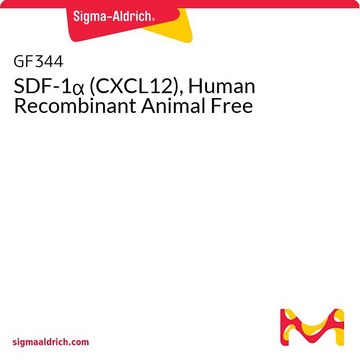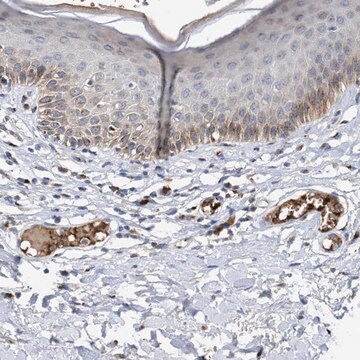AB1834P
Anti-Monocyte Chemotactic Protein-1 Antibody
Chemicon®, from rabbit
Synonim(y):
MCP-1, MCAF, CCL2
About This Item
Polecane produkty
pochodzenie biologiczne
rabbit
Poziom jakości
forma przeciwciała
affinity purified immunoglobulin
rodzaj przeciwciała
primary antibodies
klon
polyclonal
oczyszczone przez
affinity chromatography
reaktywność gatunkowa
rat
producent / nazwa handlowa
Chemicon®
metody
ELISA: suitable
neutralization: suitable
western blot: suitable
numer dostępu NCBI
numer dostępu UniProt
Warunki transportu
wet ice
docelowa modyfikacja potranslacyjna
unmodified
informacje o genach
human ... CCL2(6347)
Specyficzność
Immunogen
Zastosowanie
Western blot: 0.1 - 0.2 μg/mL, this dilution should offer a detection limit of 1.5-3.0 ng/lane, under either reducing or non-reducing conditions.
Neutralization: To yield one-half maximal inhibition [ND50] of the biological activity of rat MCP-1 (100 ng/mL), a concentration of 4.0-6.0 μg/mL of this antibody is required.
Optimal working dilutions must be determined by the end user.
Inflammation & Immunology
Cytokines & Cytokine Receptors
Postać fizyczna
Przechowywanie i stabilność
Inne uwagi
Informacje prawne
Oświadczenie o zrzeczeniu się odpowiedzialności
Nie możesz znaleźć właściwego produktu?
Wypróbuj nasz Narzędzie selektora produktów.
Kod klasy składowania
13 - Non Combustible Solids
Klasa zagrożenia wodnego (WGK)
WGK 3
Temperatura zapłonu (°F)
Not applicable
Temperatura zapłonu (°C)
Not applicable
Certyfikaty analizy (CoA)
Poszukaj Certyfikaty analizy (CoA), wpisując numer partii/serii produktów. Numery serii i partii można znaleźć na etykiecie produktu po słowach „seria” lub „partia”.
Masz już ten produkt?
Dokumenty związane z niedawno zakupionymi produktami zostały zamieszczone w Bibliotece dokumentów.
Nasz zespół naukowców ma doświadczenie we wszystkich obszarach badań, w tym w naukach przyrodniczych, materiałoznawstwie, syntezie chemicznej, chromatografii, analityce i wielu innych dziedzinach.
Skontaktuj się z zespołem ds. pomocy technicznej








